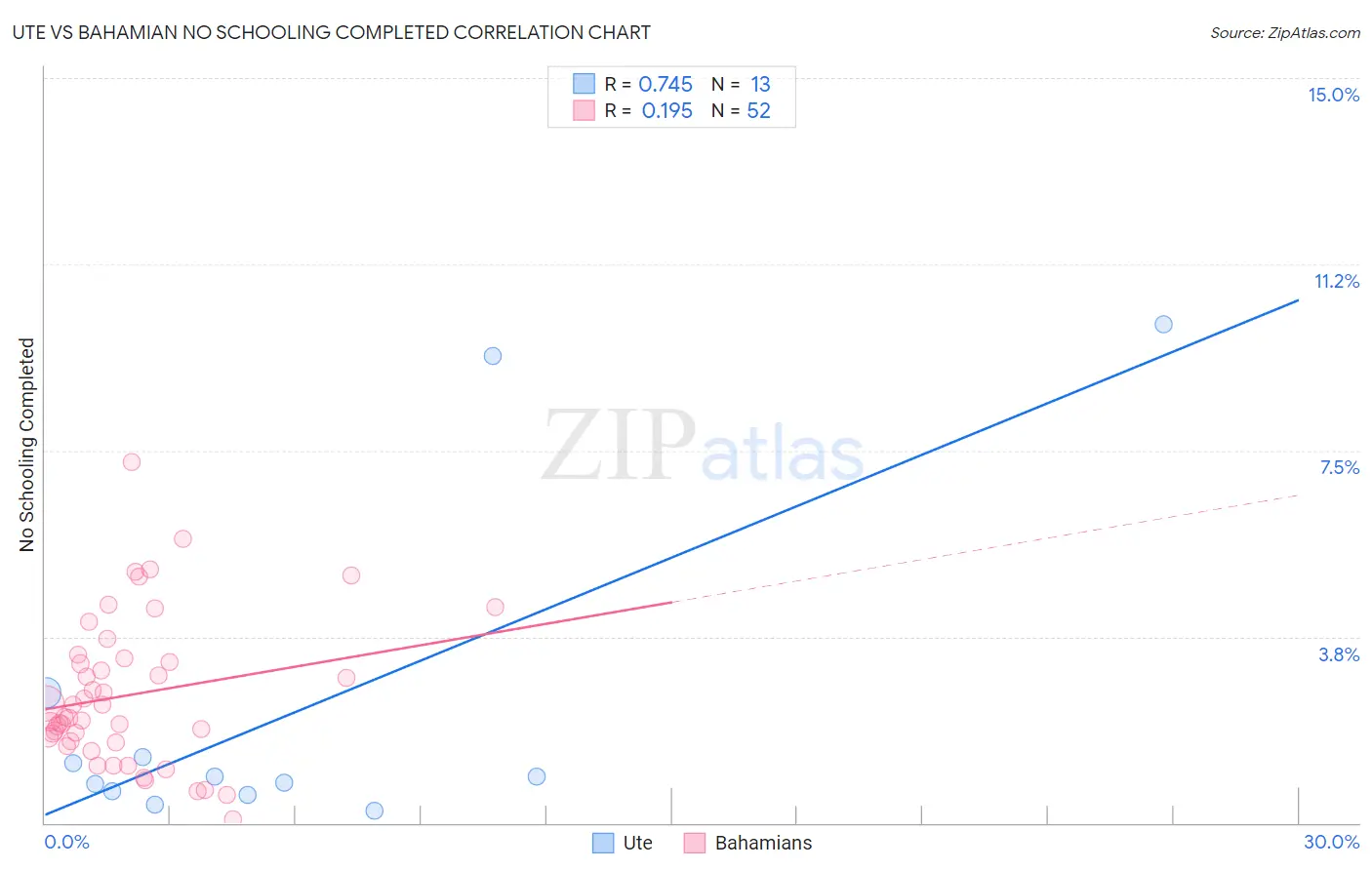Ute vs Bahamian No Schooling Completed
COMPARE
Ute
Bahamian
No Schooling Completed
No Schooling Completed Comparison
Ute
Bahamians
2.3%
NO SCHOOLING COMPLETED
8.2/ 100
METRIC RATING
213th/ 347
METRIC RANK
2.2%
NO SCHOOLING COMPLETED
11.6/ 100
METRIC RATING
206th/ 347
METRIC RANK
Ute vs Bahamian No Schooling Completed Correlation Chart
The statistical analysis conducted on geographies consisting of 55,448,088 people shows a strong positive correlation between the proportion of Ute and percentage of population with no schooling in the United States with a correlation coefficient (R) of 0.745 and weighted average of 2.3%. Similarly, the statistical analysis conducted on geographies consisting of 112,360,421 people shows a poor positive correlation between the proportion of Bahamians and percentage of population with no schooling in the United States with a correlation coefficient (R) of 0.195 and weighted average of 2.2%, a difference of 1.2%.

No Schooling Completed Correlation Summary
| Measurement | Ute | Bahamian |
| Minimum | 0.24% | 0.079% |
| Maximum | 10.1% | 7.3% |
| Range | 9.8% | 7.2% |
| Mean | 2.3% | 2.6% |
| Median | 0.92% | 2.1% |
| Interquartile 25% (IQ1) | 0.61% | 1.6% |
| Interquartile 75% (IQ3) | 2.0% | 3.3% |
| Interquartile Range (IQR) | 1.4% | 1.6% |
| Standard Deviation (Sample) | 3.4% | 1.5% |
| Standard Deviation (Population) | 3.2% | 1.5% |
Demographics Similar to Ute and Bahamians by No Schooling Completed
In terms of no schooling completed, the demographic groups most similar to Ute are Samoan (2.3%, a difference of 0.040%), Immigrants from Morocco (2.3%, a difference of 0.19%), Immigrants from Panama (2.3%, a difference of 0.20%), Immigrants from Zaire (2.3%, a difference of 0.47%), and Native/Alaskan (2.2%, a difference of 0.66%). Similarly, the demographic groups most similar to Bahamians are Immigrants from Bahamas (2.2%, a difference of 0.010%), South American Indian (2.2%, a difference of 0.18%), Uruguayan (2.2%, a difference of 0.19%), Hopi (2.2%, a difference of 0.41%), and Immigrants from Oceania (2.2%, a difference of 0.44%).
| Demographics | Rating | Rank | No Schooling Completed |
| Africans | 21.8 /100 | #199 | Fair 2.2% |
| Immigrants | Northern Africa | 19.5 /100 | #200 | Poor 2.2% |
| Costa Ricans | 17.1 /100 | #201 | Poor 2.2% |
| Moroccans | 13.7 /100 | #202 | Poor 2.2% |
| Laotians | 13.3 /100 | #203 | Poor 2.2% |
| Hopi | 12.9 /100 | #204 | Poor 2.2% |
| Immigrants | Bahamas | 11.6 /100 | #205 | Poor 2.2% |
| Bahamians | 11.6 /100 | #206 | Poor 2.2% |
| South American Indians | 11.0 /100 | #207 | Poor 2.2% |
| Uruguayans | 11.0 /100 | #208 | Poor 2.2% |
| Immigrants | Oceania | 10.2 /100 | #209 | Poor 2.2% |
| Natives/Alaskans | 10.0 /100 | #210 | Tragic 2.2% |
| Immigrants | Panama | 8.8 /100 | #211 | Tragic 2.3% |
| Immigrants | Morocco | 8.7 /100 | #212 | Tragic 2.3% |
| Ute | 8.2 /100 | #213 | Tragic 2.3% |
| Samoans | 8.2 /100 | #214 | Tragic 2.3% |
| Immigrants | Zaire | 7.2 /100 | #215 | Tragic 2.3% |
| Tongans | 6.8 /100 | #216 | Tragic 2.3% |
| Immigrants | Syria | 6.6 /100 | #217 | Tragic 2.3% |
| Immigrants | Nepal | 6.4 /100 | #218 | Tragic 2.3% |
| Senegalese | 5.6 /100 | #219 | Tragic 2.3% |